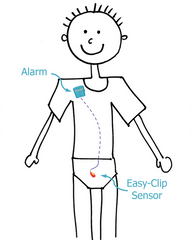Starting to use a bedwetting alarm: top 5 tips
Here's our guide to getting started with the bedwetting alarm treatment...
1. Choose the right bedwetting alarm
Firstly, it’s important to choose the alarm that’s right for your child. There’s a whole range of bedwetting alarms available and different features will appeal to different children. Some alarms are wearable, others are wireless, whilst others are bedside alarms if your child prefers not to have anything attached to them whilst they sleep. Some alarms only sound when activated, others also vibrate and some are more customisable and allow you to record a personal message. The most important thing is that your child is happy and comfortable wearing the alarm at night.

2. Make sure your child wants to become dry
In order to stay motivated with the alarm treatment, your child must really want to become dry at night. They need to understand that the goal of the bedwetting alarm is to help them to stop wetting the bed. By understanding this, they will follow the correct procedures for the alarm treatment and be motivated to keep using the alarm until they are dry.

3. Attach the alarm correctly
Of course it’s important to make sure that your child wears their alarm correctly. The sensor should be placed in the area most likely to experience the very first signs of wetting. Wearable alarms should be attached to the pyjama top, near the collar bone, with the cord to the sensor threaded below the pyjama top. Wireless alarms should be placed on a table in the room (perhaps in a place that requires your child to get out of bed to reset it). If the bedwetting alarm is worn correctly and set up properly, the alarm will sound on the very first signs of wetting and wake your child up straight away.

4. Make sure your child knows what to do when the alarm sounds
Your child needs to be clear about what they should do when the alarm is activated in the night. When the alarm sounds, they should detach the sensor from their underwear and press the “reset” button. They should then go to the bathroom to empty the rest of their bladder. For a detailed guide on what to do when the alarm sounds, read our guide in our previous blog post here.

5. Help wake your child up on the first few nights
For the first few nights, we recommend that you help your child to wake up when the alarm sounds. This will help to ensure that they are waking up and responding correctly to the alarm. After helping them for a few nights, they should then be confident to wake up, reset the alarm and go to the bathroom by themselves.

These 5 tips should help you to ensure that you start off the bedwetting alarm treatment in best and most beneficial way possible. Congratulations on taking the first steps towards dry nights! 
